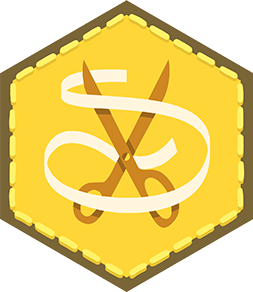Show us your embroidery skills!
Use simple stitches to embroider a colorful fabric patch, practicing patterns, patience, and fine motor skills while creating a unique mini artwork.



Step-by-step guide to embroider a colorful fabric patch
Step 1
Lay out all materials on a clean flat surface so you can reach everything easily.
Step 2
Place the fabric patch in the embroidery hoop and tighten the screw so the fabric is held snug.
Step 3
Use the fabric marker to draw a simple design like a heart star flower or swirl on the fabric.
Step 4
Cut a length of embroidery floss about 18 inches long.
Step 5
Separate the floss into two or three strands for easier stitching.
Step 6
Thread the needle with the separated strands.
Step 7
Tie a small knot at the end of the thread to stop it from pulling through the fabric.
Step 8
Use a running stitch to stitch along your drawn outline by pushing the needle in and out along the line.
Step 9
Use a satin stitch to fill a small shape by making many close parallel stitches across the shape.
Step 10
Make French knots or tiny seed stitches for dots or texture by wrapping the thread around the needle and pulling it through.
Step 11
Secure each thread on the back with a small knot so your stitches stay safe.
Step 12
Trim extra thread close to the knots using scissors.
Step 13
Share your finished embroidered patch on DIY.org so everyone can see your mini artwork.
Final steps
You're almost there! Complete all the steps, bring your creation to life, post it, and conquer the challenge!


Help!?
What can I use if I don't have an embroidery hoop or fabric patch?
Use scrap fabric or an old shirt as the fabric patch and improvise a hoop by stretching the fabric over a small plastic lid, cardboard ring, or upside-down picture frame so you can still place the fabric patch in a 'hoop' and tighten the screw.
My thread keeps tangling or the fabric puckers—how can I fix that?
Cut the embroidery floss to about 18 inches, separate it into two or three strands (as the instructions say), tighten the hoop screw so the fabric is held snug, and tie small knots and pull gently to avoid tangles and puckering.
How can I adapt this embroidery project for younger or older kids?
For younger children use thicker yarn or doubled floss, plastic blunt needles, and pre-drawn fabric marker designs while older kids can use single strands, practice satin stitch fills and French knots, and try more detailed patterns.
How can we personalize or extend the embroidered patch after finishing the basic stitches?
Enhance the patch by adding beads or sequins with embroidery floss, mixing running and satin stitches for texture, using metallic or variegated floss for color effects, or sewing the finished patch onto a backpack and sharing it on DIY.org.
Watch videos on how to embroider a colorful fabric patch
20 Basic Hand Embroidery Stitches Sampler for Absolute Beginners
Facts about embroidery and textile crafts for kids
⏳ Very detailed hand embroidery—like traditional silk techniques—can take hundreds or even thousands of hours for a single piece.
✨ Cross-stitch is a friendly beginner style because it uses simple X-shaped stitches on a grid.
🧵 Embroidery floss usually comes as a 6-strand cotton thread that you can split to make thinner details.
🪡 Embroidery needles have bigger eyes than regular sewing needles so you can thread multiple strands easily.
🎨 Samplers were used for centuries by young stitchers to practice patterns and show their skills—some are now museum pieces.
How do I embroider a small fabric patch with simple stitches?
What materials do I need to make a colorful embroidered patch?
What ages is this embroidery activity suitable for?
What are the benefits of children practicing embroidery on a fabric patch?


One subscription, many ways to play and learn.
Only $6.99 after trial. No credit card required



